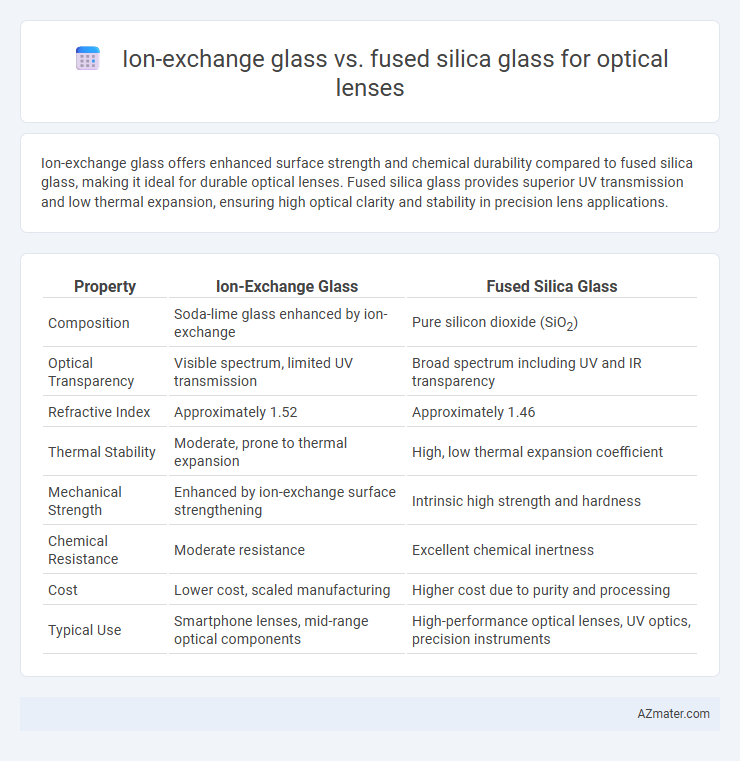Ion-exchange glass offers enhanced surface strength and chemical durability compared to fused silica glass, making it ideal for durable optical lenses. Fused silica glass provides superior UV transmission and low thermal expansion, ensuring high optical clarity and stability in precision lens applications.
Table of Comparison
| Property | Ion-Exchange Glass | Fused Silica Glass |
|---|---|---|
| Composition | Soda-lime glass enhanced by ion-exchange | Pure silicon dioxide (SiO2) |
| Optical Transparency | Visible spectrum, limited UV transmission | Broad spectrum including UV and IR transparency |
| Refractive Index | Approximately 1.52 | Approximately 1.46 |
| Thermal Stability | Moderate, prone to thermal expansion | High, low thermal expansion coefficient |
| Mechanical Strength | Enhanced by ion-exchange surface strengthening | Intrinsic high strength and hardness |
| Chemical Resistance | Moderate resistance | Excellent chemical inertness |
| Cost | Lower cost, scaled manufacturing | Higher cost due to purity and processing |
| Typical Use | Smartphone lenses, mid-range optical components | High-performance optical lenses, UV optics, precision instruments |
Introduction to Ion-Exchange Glass and Fused Silica Glass
Ion-exchange glass enhances surface strength and scratch resistance by swapping smaller ions with larger alkali ions in a chemical bath, making it ideal for durable optical lenses. Fused silica glass, composed of high-purity silicon dioxide, offers exceptional thermal stability, low thermal expansion, and superior transparency in ultraviolet to infrared wavelengths. These properties make fused silica highly suitable for precision optical applications requiring minimal distortion and high laser damage threshold.
Chemical Composition and Manufacturing Processes
Ion-exchange glass for optical lenses is primarily made from aluminosilicate glass, wherein alkali ions like sodium are replaced with larger potassium ions through an ion-exchange process to enhance strength and durability. Fused silica glass consists almost entirely of pure silicon dioxide (SiO2), produced by melting high-purity quartz at temperatures above 2000degC, resulting in exceptional thermal stability and optical clarity. The ion-exchange manufacturing involves chemical treatment at relatively low temperatures, whereas fused silica formation requires high-temperature melting and controlled cooling to produce a homogeneous, defect-free optical material.
Optical Clarity and Transmission Properties
Ion-exchange glass offers enhanced surface strength but typically exhibits slightly lower optical clarity and transmission properties compared to fused silica glass. Fused silica glass provides superior optical clarity with high transparency across ultraviolet to infrared wavelengths, ensuring minimal light scatter and maximum transmission efficiency. The high purity and homogeneity of fused silica make it the preferred material for precision optical lenses requiring exceptional clarity and broad spectral performance.
Mechanical Strength and Durability
Ion-exchange glass exhibits superior mechanical strength due to its chemically reinforced surface layer, resulting in enhanced resistance to scratches and breakage compared to fused silica glass. Fused silica glass offers exceptional thermal stability and chemical durability but is more prone to mechanical damage under impact or flexural stress. Optical lenses made from ion-exchange glass provide increased longevity and reliability in demanding environments where mechanical robustness is critical.
Thermal Stability and Resistance
Ion-exchange glass for optical lenses offers enhanced thermal stability due to its surface compressive stress layer, which improves resistance to thermal shock and mechanical damage. Fused silica glass exhibits superior thermal resistance with a high melting point around 1710degC and excellent dimensional stability under extreme temperature fluctuations, making it ideal for high-temperature applications. Compared to fused silica, ion-exchange glass provides better surface durability but lower overall thermal resistance, influencing material choice based on specific thermal performance requirements.
Refractive Index and Optical Performance
Ion-exchange glass for optical lenses offers a higher refractive index compared to fused silica glass, enhancing light-bending capabilities and image sharpness. Fused silica glass provides superior optical performance with excellent transmission in UV to IR wavelengths and minimal chromatic aberration due to its low dispersion properties. The choice between ion-exchange glass and fused silica depends on balancing refractive index requirements with optical clarity and wavelength transmission needs.
Cost Efficiency and Scalability
Ion-exchange glass offers improved surface hardness and scratch resistance compared to standard fused silica glass, making it more cost-efficient for high-durability optical lenses in large-scale production. Fused silica glass excels in thermal stability and optical clarity but involves higher raw material costs and longer processing times, limiting its scalability for mass manufacturing. Manufacturers prioritize ion-exchange glass for cost-effective, scalable solutions while selecting fused silica for precision optics demanding superior transmission and low thermal expansion.
Suitability for High-Precision Applications
Ion-exchange glass offers superior surface compressive stress, enhancing durability and resistance to scratches, making it ideal for high-precision optical lenses used in demanding environments. Fused silica glass provides exceptional thermal stability and low birefringence, ensuring minimal optical distortion and high transmission in UV and IR ranges, critical for precision applications in laser systems and scientific instruments. The choice between ion-exchange and fused silica glass hinges on specific performance requirements such as mechanical strength versus optical clarity under varying wavelengths.
Environmental Impact and Sustainability
Ion-exchange glass offers enhanced strength and durability for optical lenses but involves chemical processes that generate hazardous waste, impacting environmental sustainability. Fused silica glass, made from pure silicon dioxide, boasts superior thermal stability and lower environmental toxicity during manufacturing, making it more sustainable. The energy-intensive production of fused silica is offset by its recyclability and longer lifespan, reducing overall environmental footprint compared to ion-exchange glass.
Conclusion: Choosing the Right Glass for Optical Lenses
Ion-exchange glass offers enhanced surface strength and scratch resistance, making it ideal for high-durability optical lenses in rugged applications. Fused silica glass provides superior thermal stability, low thermal expansion, and exceptional UV transparency, suitable for precision optics and harsh environmental conditions. Selecting the right glass depends on balancing mechanical durability and optical performance requirements specific to the lens application.

Infographic: Ion-exchange glass vs Fused silica glass for Optical lens
 azmater.com
azmater.com